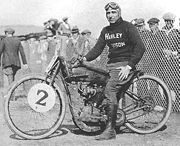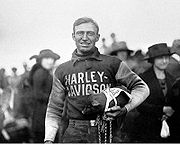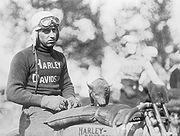
Ray Weishaar
Encyclopedia




Harley-Davidson
Harley-Davidson , often abbreviated H-D or Harley, is an American motorcycle manufacturer. Founded in Milwaukee, Wisconsin, during the first decade of the 20th century, it was one of two major American motorcycle manufacturers to survive the Great Depression...
'Wrecking Crew,' and helped to popularize the nickname 'hog' in reference to Harley-Davidson by carrying the team's mascot, a small pig, around on victory laps.
Early life
Lawrence Ray Weishaar was born on September 9, 1890 in OklahomaOklahoma
Oklahoma is a state located in the South Central region of the United States of America. With an estimated 3,751,351 residents as of the 2010 census and a land area of 68,667 square miles , Oklahoma is the 28th most populous and 20th-largest state...
; he grew up in Wichita, Kansas
Wichita, Kansas
Wichita is the largest city in the U.S. state of Kansas.As of the 2010 census, the city population was 382,368. Located in south-central Kansas on the Arkansas River, Wichita is the county seat of Sedgwick County and the principal city of the Wichita metropolitan area...
. His father died when he was only nine years old, leaving him and his mother with little to live on. Weishaar sought work to help support his family, and as a teenager he got a job with Bell Telephone
Bell Telephone
Bell Telephone may refer to:* Bell Telephone Company, several telephone companies with similar names* Bell Telephone Building , various* The Bell Telephone Hour, a long-running radio and television concert program...
. He eventually saved up enough money to buy himself a motorcycle which was, at the time, the most cost-effective form of transportation.
Career
Weishaar began racing the half-mile circuits of various county fairs around Kansas between 1908 and 1910. He earned the nickname, "Kansas Cyclone," and subsequently won the Kansas State Championship two years in a row. The second time around on the championship race, one of the handlebars on his motorcycle broke off, yet he still managed to win the race (but he did not break his previous record).Weishaar was racing on the national circuit by 1914, with the national event in Savannah, Georgia
Savannah, Georgia
Savannah is the largest city and the county seat of Chatham County, in the U.S. state of Georgia. Established in 1733, the city of Savannah was the colonial capital of the Province of Georgia and later the first state capital of Georgia. Today Savannah is an industrial center and an important...
being his first big race. He was forced to drop out of the race on the 24th lap when his gas tank began leaking; at the time he was vying for the first place position. In 1915, at the Dodge City 300, a malfunctioning spark plug caused him to lose, and he also lost a 300-mile race at the Chicago Speedway due to his helmet strap coming loose, but that same year he claimed a victory in a 100 mile race in Pratt, Kansas.
The following article appeared in the September 1915 issue of The Harley-Davidson Dealer:
Ray Weishaar Hung on to his Helmet Four Laps With his Teeth
(Chicago Speedway, September 12, 1915)
"In the 13th lap, however, his helmet became unfastened, Weishaar
hung on to the strings with his teeth for four laps and then threw the
helmet into the pits.
Chairman John L. Donovan of the F.A.M. copetition committee and
Referee Frank E. Yates saw the helmet go into the pits and insisted
on knowing to whom it beloged. There was considerable dispute for
several laps as a result of their determination to make Weishaar stop
and put on his helmet again.
As Weishaar came around each lap in the lead, those of us who where in
the pits did out best to argue the officials out of their idea of forcing
Weishaar to make an extra stop but they were determined in their course
and as a result we had to call Weishaar into the pits in the 27th lap. This
undoubtedly cost Weishaar the race." (The Harley-Davidson Dealer September 1915)
Weishaar was made a part of the Harley-Davidson factory team in 1916. That year he came in third place at Dodge City, and he won the FAM 100-Mile Championship in Detroit. He became a dealer of Harley-Davidson motorcycles for three years after being given a dealership, but he returned to racing in 1919.
His greatest victory was in Indiana
Indiana
Indiana is a US state, admitted to the United States as the 19th on December 11, 1816. It is located in the Midwestern United States and Great Lakes Region. With 6,483,802 residents, the state is ranked 15th in population and 16th in population density. Indiana is ranked 38th in land area and is...
, in the Marion Cornfield Classic Road Race, which took place in 1920. He won the race, as well as beating the standing race record by 18 minutes.
The Harley-Davidson team's mascot was a small pig, which they would take around the track with them on victory laps. Weishaar was particularly fond of it, and many photographs exist of him and the pig. It is because of this mascot that Harley-Davidson motorcycles are called "hogs."
Weishaar had a reputation as a cautious rider who often succumbed to the forces of bad luck. Many times he would be leading national events only to be forced to drop out to equipment malfunction. In 1923 he moved to Los Angeles after signing a contract to race at the newly built Legion Ascot Speedway.
Death
On April 13, 1924, Weishaar was battling Gene Walker (who rode for the IndianIndian (motorcycle)
Indian is an American brand of motorcycles. Indian motorcycles were manufactured from 1901 to 1953 by a company in Springfield, Massachusetts, USA, initially known as the Hendee Manufacturing Company but which was renamed the Indian Manufacturing Company in 1928. The Indian factory team took the...
factory). Johnny Seymour had drafted past both Walker and Weishaar, which sent Weishaar's motorcycle into a high-speed wobble
Speed wobble
Wobble, shimmy, tank-slapper, speed wobble, and even death wobble are all words and phrases used to describe a quick oscillation of primarily just the steerable wheel of a vehicle. Initially, the rest of the vehicle remains mostly unaffected, until translated into a vehicle yaw oscillation of...
. The motorcycle went into a skid; Weishaar fought to save it, but before he could do so he hit the outside fence. Weishaar went through the wooden fence and wrecked. He was still conscious and no one thought him to be seriously injured. His wife, Emma, drove him to the Los Angeles General Hospital, where he died in a matter of hours from his internal injuries. He was 33 years old.
Response From the Racing Industry
Weishaar's death, along with the death of Gene WalkerGene Walker
-Gene Walker:In 1910, Walker obtained his first motorcycle, an Excelsior. At 17 he worked as a postal delivery person in Birmingham using an Indian motorcycle for delivering mail. Walker entered his first motorcycle race at the 1912 Alabama State Fair and won the five-mile final...
two months later, caused the motorcycle racing industry to slow down the speeds of the bikes at the time. Smaller engine classes were created, but as with most racing sports the speeds began to climb again.

